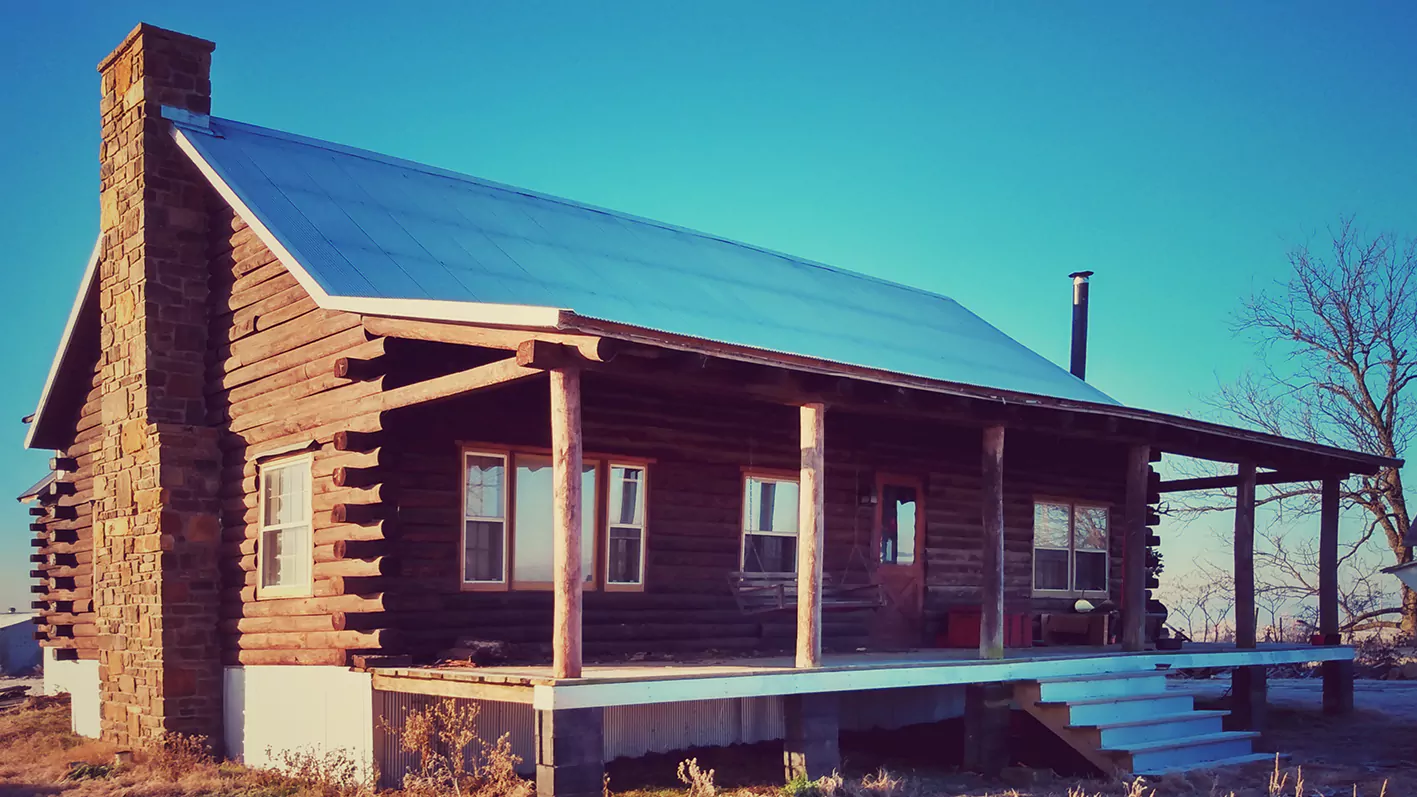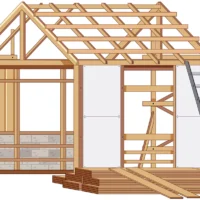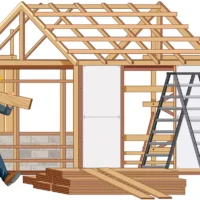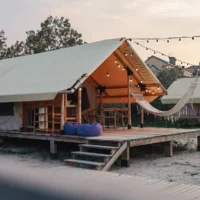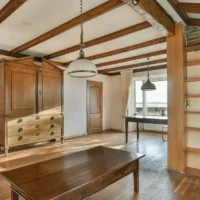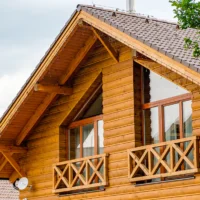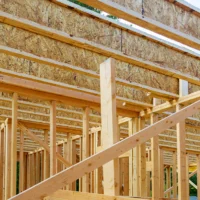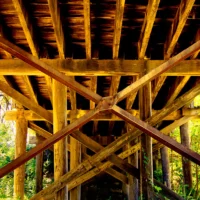Table of Contents
Introduction: Why Log Cabin Farmhouses Are Gaining Popularity
In recent years, log cabin farmhouses have seen a surge in popularity among homeowners seeking a harmonious blend of rustic living and modern convenience. These homes, rooted in tradition yet versatile enough for contemporary lifestyles, offer a peaceful escape from urban life while embracing the simplicity and practicality of farmhouse design. Whether you’re dreaming of a rural retreat or a permanent residence, log cabin farmhouses promise comfort, character, and timeless appeal.
What Makes a Log Cabin Farmhouse Unique?
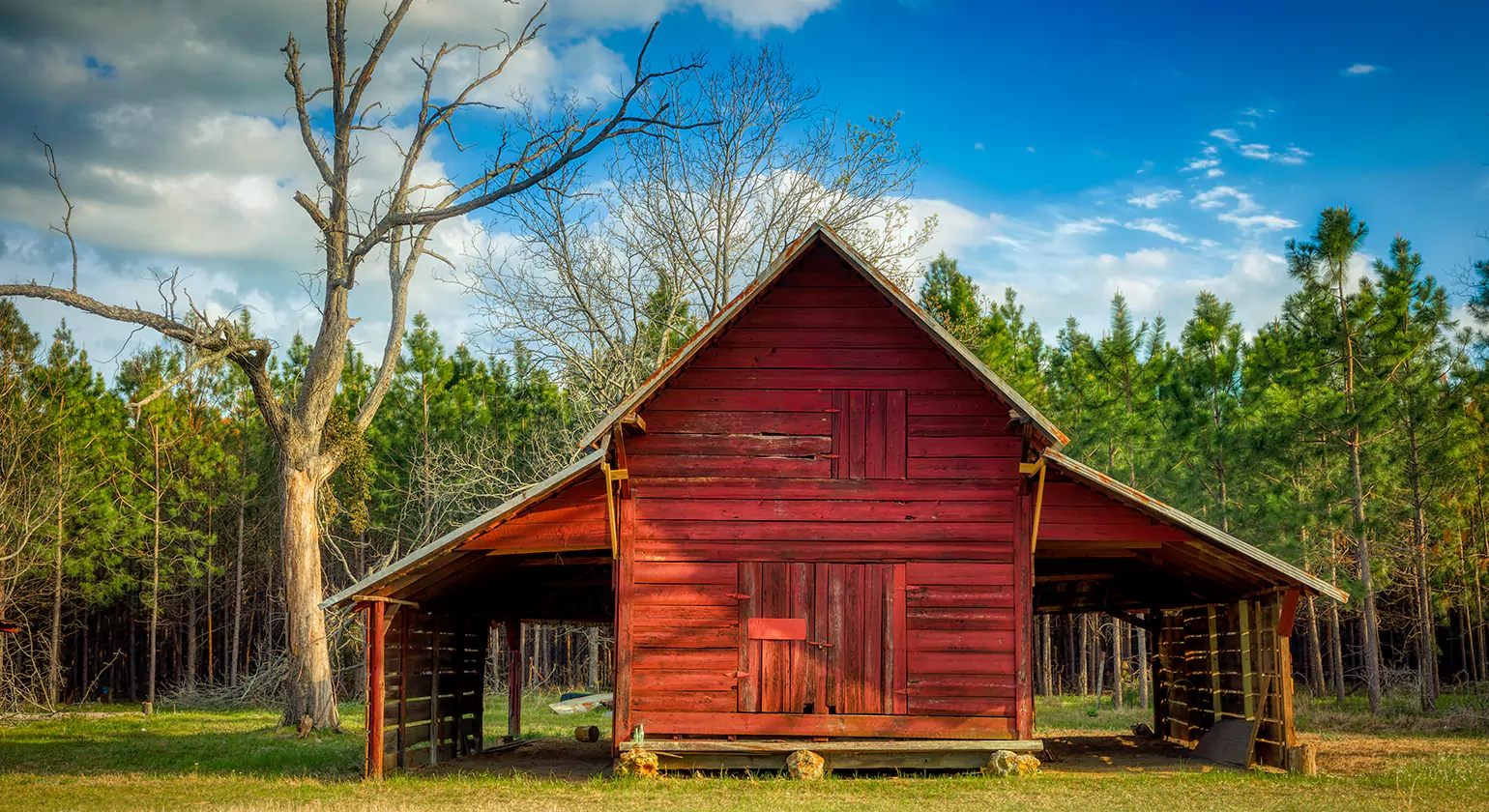
Unlike traditional cabins or modern farmhouses alone, log cabin farmhouses combine the best of both worlds. They showcase the handcrafted beauty of log construction—natural textures, exposed wood, and earthy tones—with the functional, cozy, and airy qualities of farmhouse architecture. The result is a home that exudes authenticity, warmth, and charm.
The structure typically features hand-hewn logs, steep-pitched metal or shingle roofs, wide porches, and large open interiors. With a strong connection to the outdoors, these homes are as beautiful as they are sustainable. The use of natural materials reduces environmental impact, while energy-efficient windows and modern insulation keep interiors comfortable year-round.
The Appeal of Log Cabins
Log cabins have been part of American history since the frontier days. Known for their durability and natural aesthetics, these homes have always symbolized resilience, craftsmanship, and a connection to nature. In log cabin farmhouses, this legacy continues—but with upgraded design elements and modern amenities.
Today’s homeowners are increasingly drawn to log cabin farmhouses for their:
- Timeless visual appeal
- Structural strength and energy efficiency
- Minimal maintenance when properly treated
- Connection to rural and wooded landscapes
Whether built from pine, cedar, or oak, each log brings its own character, helping to craft a unique and personal home environment.
Farmhouse Style: A Touch of Practicality
While log cabins bring rustic charm, the farmhouse design element introduces practicality and comfort. Characterized by open floor plans, simple lines, and functional layouts, farmhouse architecture maximizes living space without compromising on coziness.
Key features of farmhouse style include:
- Neutral color palettes
- Shiplap walls and reclaimed wood accents
- Apron-front sinks and large kitchen islands
- Sliding barn doors and vintage-style lighting
When you blend these farmhouse elements with natural logs, you create a log cabin farmhouse that feels both nostalgic and fresh. This style resonates with homeowners seeking a relaxed, livable space that doesn’t feel overly modern or sterile.
Key Features of Log Cabin Farmhouses
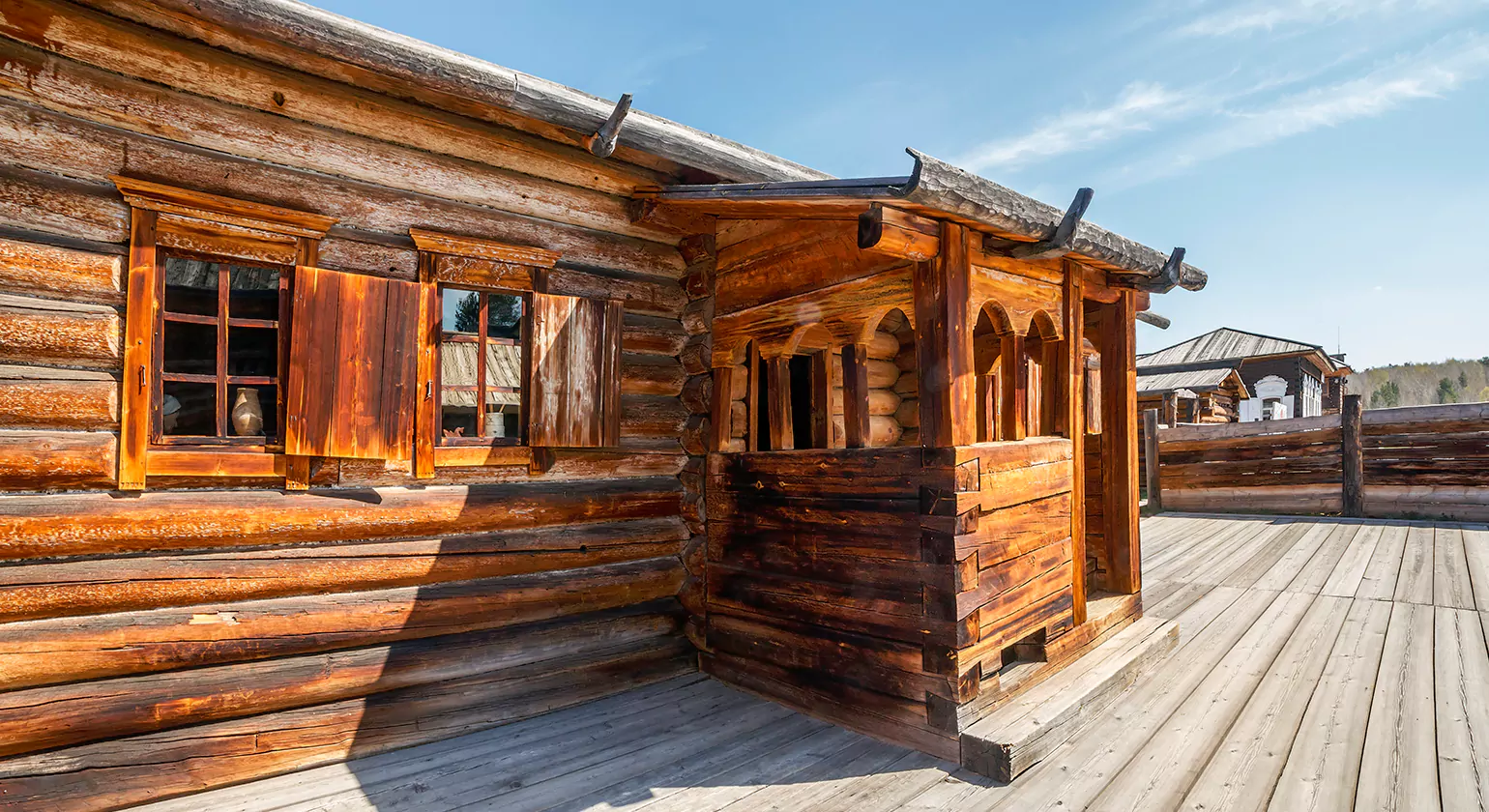
To truly understand the appeal of log cabin farmhouses, it’s important to highlight their defining characteristics. Here are some of the most common and sought-after features:
1. Exposed Log Walls and Beams
The raw beauty of hand-peeled logs is a signature element, providing texture, warmth, and architectural interest.
2. Wraparound Porches
A hallmark of both log homes and farmhouses, large porches offer the perfect place for relaxing, entertaining, or enjoying panoramic views of the countryside.
3. Vaulted Ceilings
High, cathedral-style ceilings add spaciousness and elegance to the living area, enhancing airflow and natural light.
4. Stone Fireplaces
Whether wood-burning or gas, a stone fireplace anchors the home, offering both ambiance and heat during colder months.
5. Open Floor Plans
Log cabin farmhouses typically embrace open layouts that encourage easy movement between kitchen, dining, and living spaces.
6. Rustic Finishes
Wide plank hardwood floors, butcher block counters, wrought iron fixtures, and antique hardware add layers of texture and authenticity.
7. Energy-Efficient Windows
Modern log cabin farmhouses utilize high-performance windows to let in abundant sunlight while maintaining insulation.
Rustic Charm Meets Modern Comfort
While these homes evoke a nostalgic past, log cabin farmhouses are far from outdated. In fact, their design accommodates all the comforts of modern living. Smart home technology, radiant heat flooring, and gourmet kitchens are often integrated seamlessly into the rustic shell.
This fusion of old and new ensures that homeowners can enjoy the visual and emotional benefits of log home living without sacrificing luxury. Whether you’re working remotely, entertaining guests, or just enjoying a peaceful weekend at home, log cabin farmhouses deliver a well-rounded lifestyle.
Open Spaces and Natural Light
One of the defining elements of log cabin farmhouses is their embrace of open space and natural light. Large windows, skylights, and open-concept layouts allow sunlight to pour in, illuminating the rich grains of the wood and highlighting the craftsmanship of the home.
This design philosophy aligns with the farmhouse ethos of simplicity and function—where every element has a purpose, and nothing feels cluttered. The natural openness promotes wellness, making log cabin farmhouses ideal for families, retirees, and anyone seeking a tranquil yet vibrant home environment.
Designing Your Own Log Cabin Farmhouse
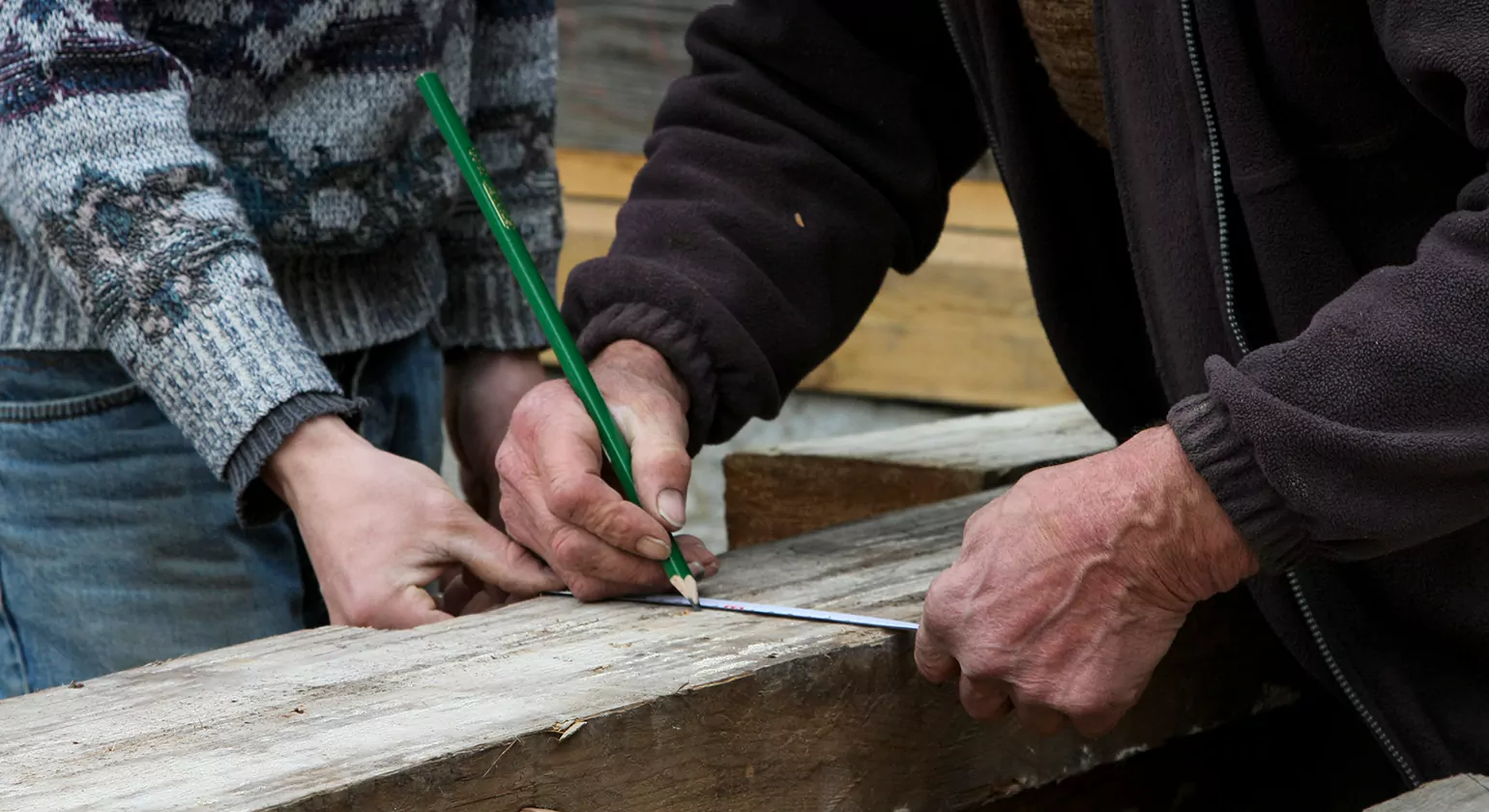
Designing a log cabin farmhouse gives you the rare opportunity to combine rustic tradition with modern practicality. This unique architectural style is perfect for those who dream of a cozy, nature-inspired retreat that’s both timeless and livable. From floor plans to interior design ideas, every detail contributes to the warmth and character of a log cabin farmhouse.
Essential Design Elements
When designing your own log cabin farmhouse, it’s crucial to focus on the core features that define both architectural styles.
1. Natural Wood Construction
Logs are the soul of your home. Choose high-quality timber like pine, cedar, or oak. The natural grain, texture, and warm hues set the tone for the entire space.
2. Gabled Rooflines
Gabled or pitched roofs not only enhance the farmhouse profile but also help with snow and rain runoff in all seasons.
3. Wide Front Porches
One of the hallmarks of a log cabin farmhouse, a wraparound porch, creates an inviting entry point and encourages outdoor relaxation.
4. Open-Concept Layouts
Combining the farmhouse’s practicality with the log cabin’s spaciousness results in flowing, functional spaces that feel expansive and connected.
Combining Log Cabin and Farmhouse Aesthetics
Creating a unified log cabin farmhouse requires careful blending rugged cabin textures with the refined simplicity of farmhouse style.
- Use reclaimed barn wood, shiplap accents, or board and batten siding to complement log walls.
- Choose a neutral farmhouse color palette—creams, greys, and soft greens—balanced by the natural warmth of the wood.
- Incorporate farmhouse details like barn doors, black matte fixtures, and vintage lighting to modernize the rustic shell.
This hybrid style emphasizes balance—between elegance and earthiness, between minimalism and cozy clutter.
Choosing the Right Floor Plan
The layout of your log cabin farmhouse should reflect your lifestyle. Whether you’re building a family home, vacation property, or retirement retreat, here are some key planning tips:
1. Prioritize Open Common Areas
Design a great room that merges the kitchen, dining, and living space. This layout encourages social interaction while showcasing the grand log construction.
2. Zone for Function
Farmhouses traditionally keep mudrooms, pantries, and laundry rooms near entrances. Use this strategy in your log cabin farmhouse to enhance functionality.
3. Maximize Natural Light
Include large windows and skylights throughout the home, especially in the main living area and bedrooms. Natural light brings wood tones to life.
4. Plan for Outdoor Access
Design your floor plan with multiple exits to porches, decks, and gardens. This reinforces the connection to nature—a key feature of any log cabin farmhouse.
Log Cabin Farmhouse Interior Design Ideas
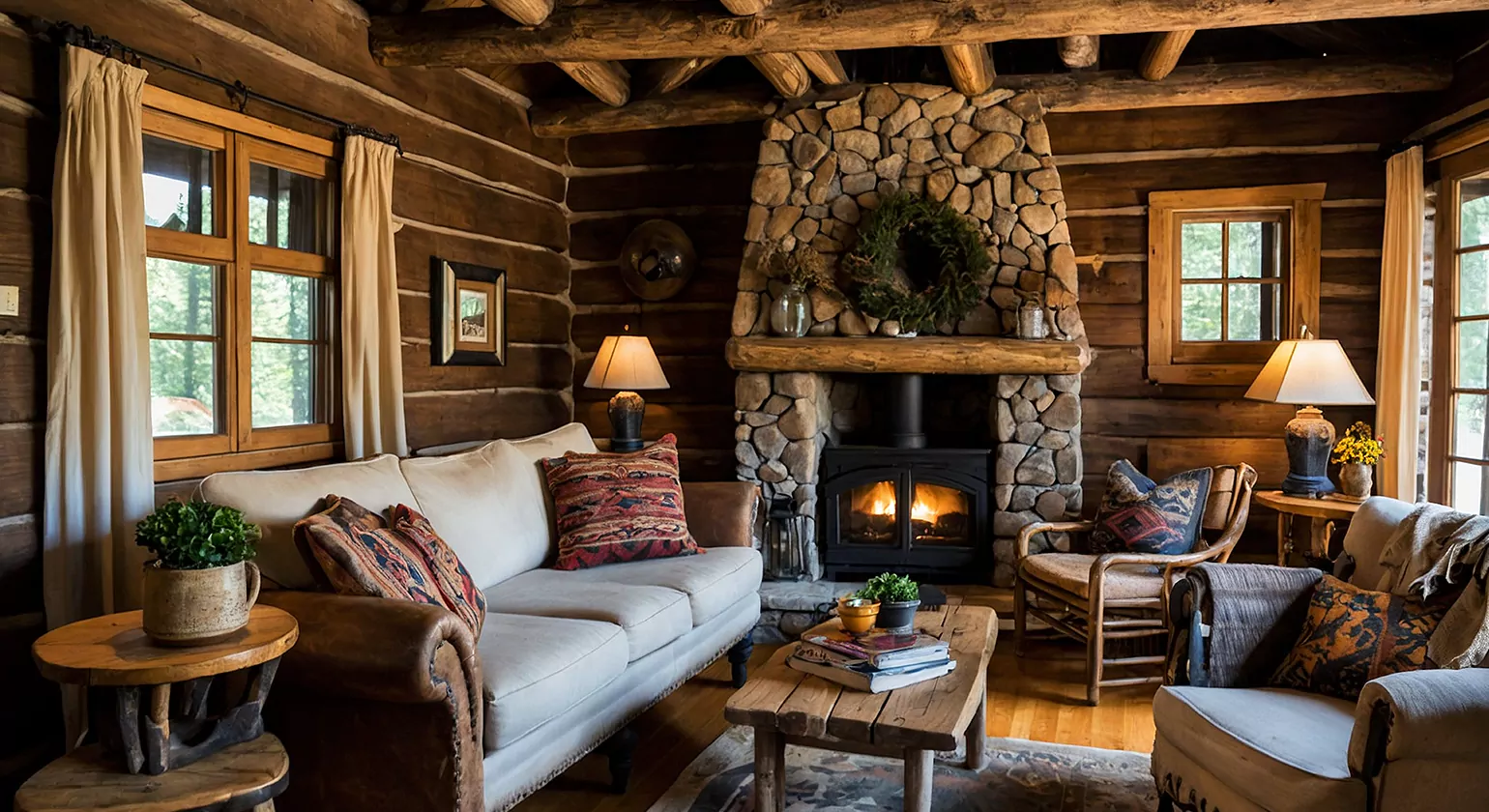
The interiors of log cabin farmhouses should be both comfortable and visually harmonious. Here’s how to design rooms that radiate warmth, style, and purpose.
Cozy Living Rooms with Rustic Charm
The living room is the heart of any log cabin farmhouse. To enhance its rustic charm:
- Use a stone or brick fireplace as a central feature.
- Select overstuffed leather or linen furniture for a cozy feel.
- Incorporate woven rugs, plaid textiles, and antique furnishings to layer texture.
- Leave the exposed log walls and ceiling beams visible for character and contrast.
Add personal touches like vintage signs, old maps, or handmade décor to reflect your family’s style.
Farmhouse Kitchens: Function Meets Style
In your log cabin farmhouse, the kitchen should marry old-world charm with modern convenience.
- Install a large farmhouse sink, open shelving, and a kitchen island with butcher-block or stone countertops.
- Opt for cabinetry in soft hues like sage, cream, or navy blue.
- Hang pendant lights above the island for both illumination and farmhouse flair.
- Mix stainless steel appliances with rustic materials for a balanced aesthetic.
Storage, efficiency, and warmth should guide every design decision here.
Log Cabin Bedrooms for Ultimate Comfort
Bedrooms in a log cabin farmhouse should feel like a peaceful retreat from the world. Design for both relaxation and style.
- Use log or reclaimed wood bed frames.
- Choose natural textiles—linen, cotton, and wool—for bedding and window treatments.
- Add warmth with a wool throw, vintage quilt, or fur accent.
- Incorporate soft lighting through wall sconces or antique bedside lamps.
Don’t forget a window view of your natural surroundings—one of the biggest perks of living in a log cabin farmhouse.
Outdoor Living: Enhancing Your Log Cabin Farmhouse
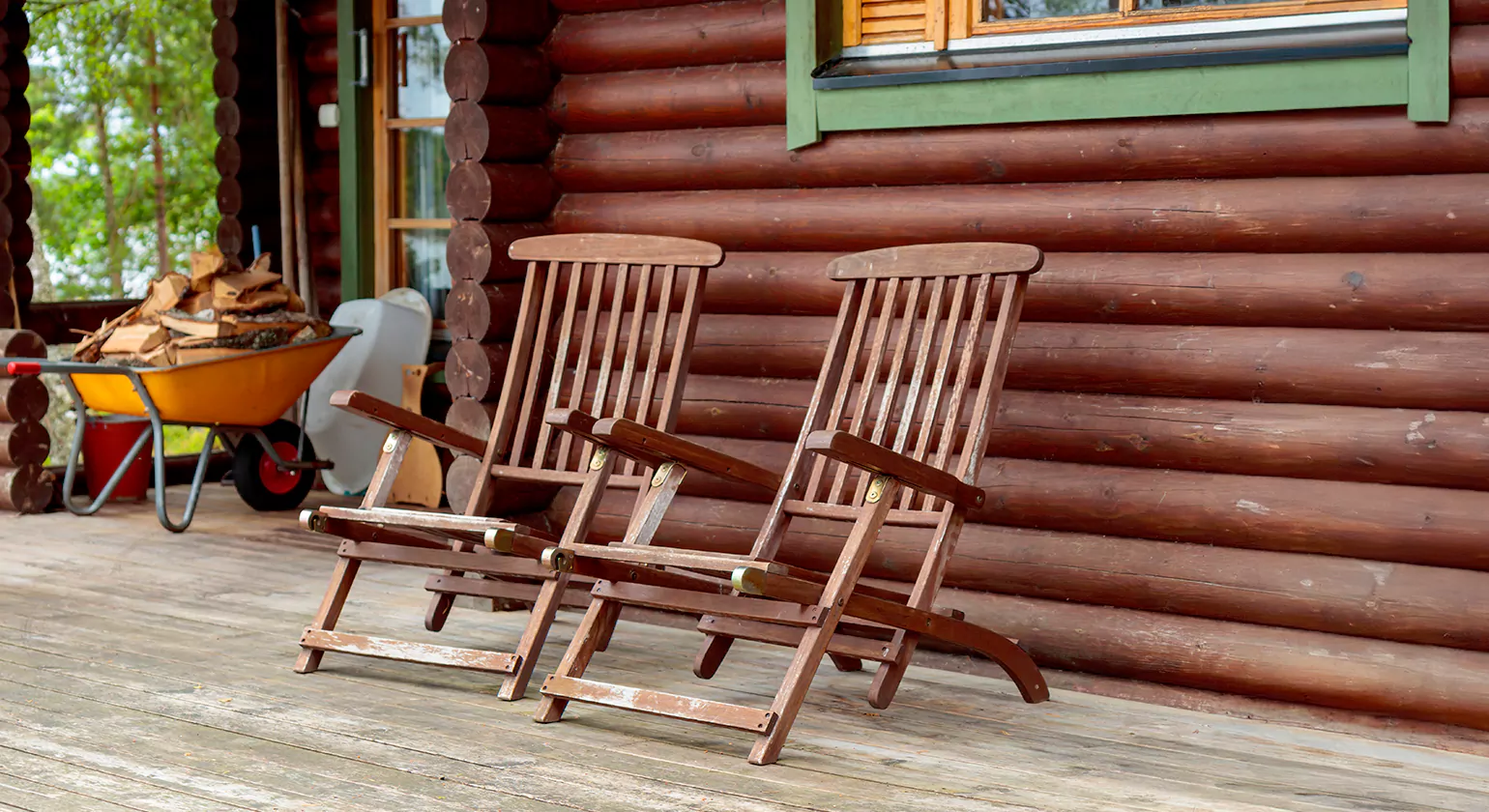
Outdoor spaces extend the comfort of your home into the natural world. These areas are just as important as the interiors of a log cabin farmhouse.
Creating a Rustic Farmhouse Garden
Gardens are central to farmhouse living. Whether for vegetables, herbs, or flowers, make your garden an extension of your design.
- Use raised beds, wooden planters, or stone borders to frame the garden.
- Incorporate elements like chicken coops, greenhouses, or compost bins for authenticity.
- Add a gravel pathway, wrought iron benches, and a rustic arbor for charm.
This adds both beauty and function to your log cabin farmhouse landscape.
Outdoor Patios and Decks for Relaxation
Your deck or patio should feel like a continuation of your interior design.
- Use natural wood for decking to match your log cabin’s exterior.
- Add outdoor furniture with weatherproof cushions in farmhouse-style fabrics.
- Install a firepit, outdoor kitchen, or pergola to maximize usability.
- Include hanging string lights or lanterns to make evenings magical.
A thoughtfully designed outdoor area enhances your log cabin farmhouse lifestyle and increases property value.
How to Build a Log Cabin Farmhouse: Step-by-Step Guide
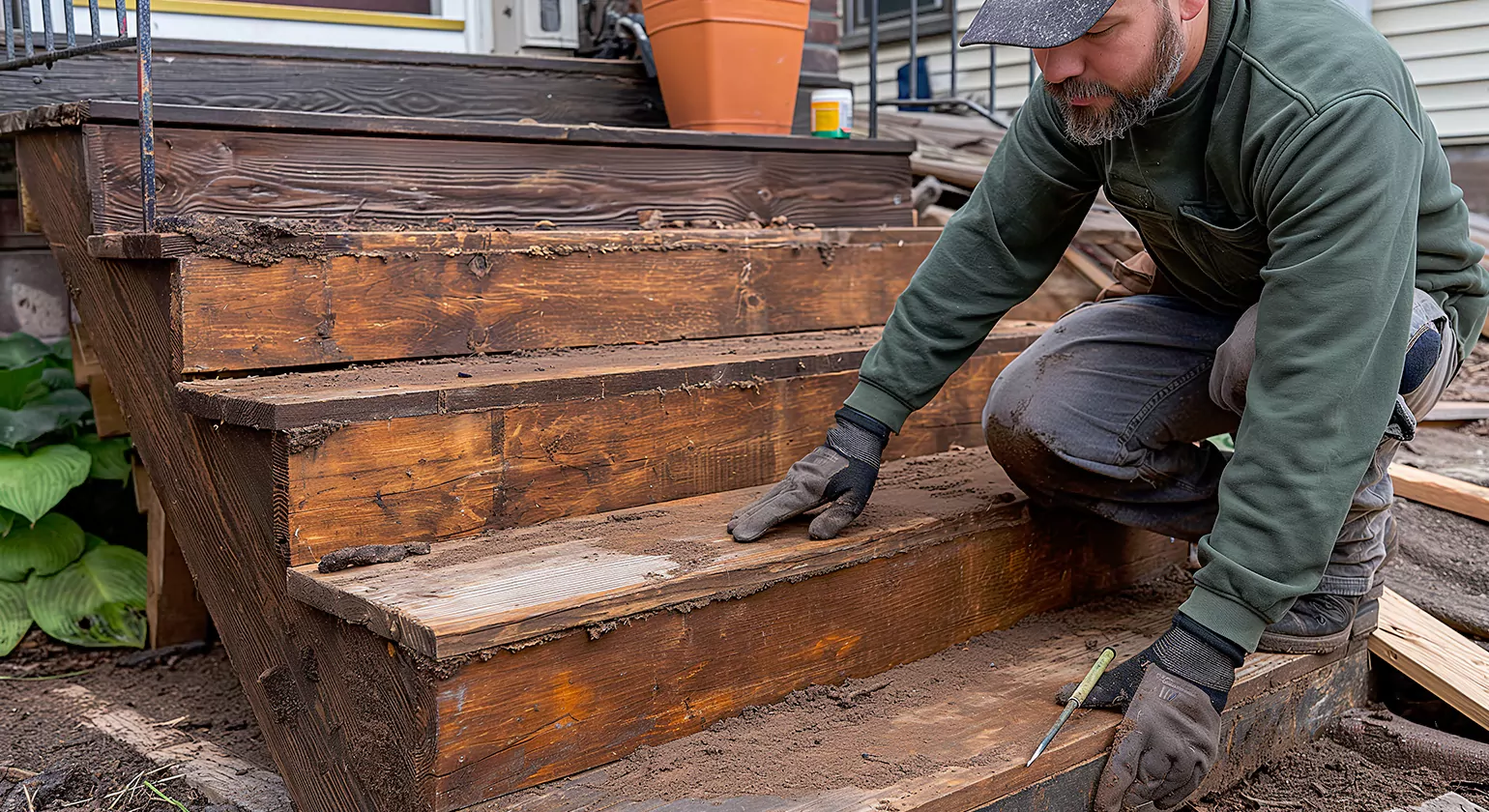
Building a log cabin farmhouse is a rewarding endeavor that combines rustic charm with functional farmhouse living. Whether you’re creating a cozy weekend retreat or a full-time residence, this home style offers timeless appeal, sustainable materials, and unmatched natural beauty. In this comprehensive guide, you’ll discover how to build your own log cabin farmhouse, from materials and planning to maintenance and buying tips.
Materials Needed
The foundation of any log cabin farmhouse starts with the right materials. Selecting high-quality, durable, and sustainable materials is essential for both aesthetics and longevity.
Key Materials for Building a Log Cabin Farmhouse:
- Logs or Timber (Cedar, Pine, Oak): Choose logs that are kiln-dried and treated to resist moisture, insects, and warping.
- Stone or Concrete: For foundations, fireplaces, and chimneys.
- Roofing Materials: Metal roofing or asphalt shingles are common for durability and style.
- Windows and Doors: Energy-efficient models that fit rustic aesthetics (think wood frames with double or triple glazing).
- Interior Finishes: Reclaimed wood, shiplap, stone, and farmhouse fixtures.
- Insulation: Spray foam or natural wool insulation to keep your log cabin farmhouse energy efficient.
Investing in quality materials not only enhances visual appeal but also ensures your home stands the test of time.
Planning and Budgeting for Your Build
Before you start construction, proper planning is essential to avoid costly surprises.
1. Set a Realistic Budget
On average, building a log cabin farmhouse costs between $125 and $250 per square foot, depending on design complexity and material choices.
2. Hire an Architect or Log Home Designer
Partnering with professionals who specialize in log home design ensures that your vision translates into a safe, structurally sound, and efficient layout.
3. Get Necessary Permits
Check local zoning laws, building codes, and HOA regulations before construction begins.
4. Choose the Right Floor Plan
Select or customize a plan that maximizes open living space, embraces natural light, and integrates farmhouse features such as wide porches and spacious kitchens.
5. Consider Utilities and Septic Systems
Plan for water, electricity, heating, and septic systems—especially important for off-grid or rural locations.
Log Cabin Farmhouse Maintenance Tips
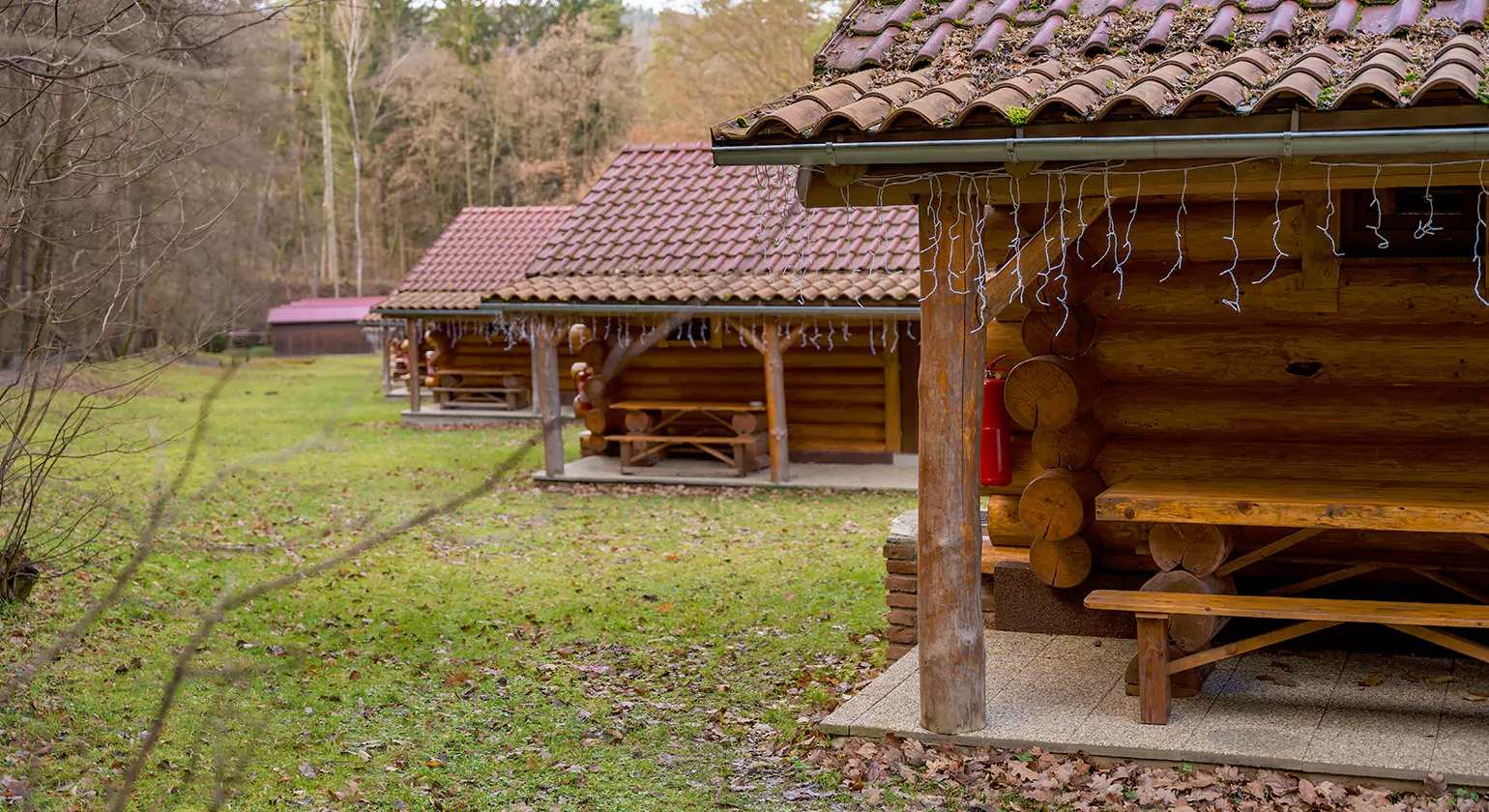
Owning a log cabin farmhouse means keeping your home in peak condition through regular maintenance. While log homes are durable, they require specific care to maintain their beauty and structural integrity.
Keeping Your Logs Beautiful and Durable
1. Staining and Sealing
Apply a weather-resistant stain every 3–5 years to protect your logs from UV rays, moisture, and pests.
2. Inspect for Cracks (Checks)
Minor cracks are normal, but larger gaps should be sealed to prevent water intrusion and insect activity.
3. Gutter and Roof Maintenance
Ensure that gutters and downspouts are clear and that your roof is inspected seasonally to prevent leaks or water damage.
4. Pest Control
Keep an eye out for termites, carpenter bees, or ants. Preventive treatment and regular inspections are key.
Farmhouse Maintenance Checklist
To maintain the farmhouse elements of your log cabin farmhouse, follow this seasonal checklist:
- Spring: Check siding, clean windows, and inspect porch wood for damage.
- Summer: Power wash decks, repaint or touch-up trims, clean outdoor furniture.
- Fall: Inspect chimneys and fireplaces, prepare HVAC systems, seal cracks in windows or doors.
- Winter: Check insulation and pipes; remove snow buildup from roofs and decks.
These small efforts go a long way towards preserving your home’s value and livability.
Where to Find Log Cabin Farmhouses for Sale
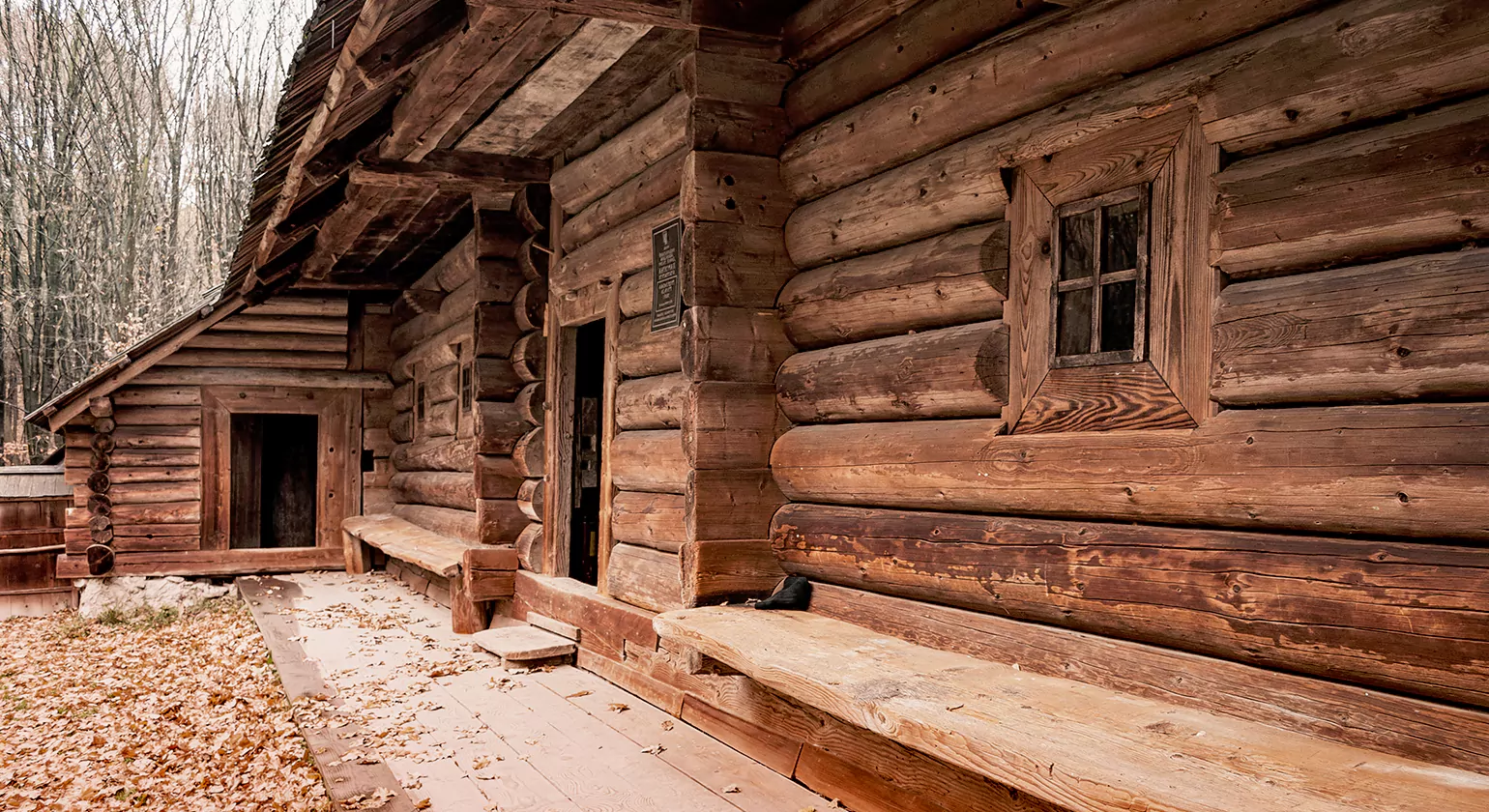
If building from scratch isn’t your path, there are plenty of log cabin farmhouses for sale across the country. Whether you want a turnkey home or a fixer-upper to make your own, knowing where to look is crucial.
Start Your Search On:
- Zillow & Realtor.com: Use filters like “log home,” “cabin,” and “farmhouse” to narrow your options.
- Specialized Log Home Websites: Sites like LogHomes.com and LogCabinHub feature listings from across North America.
- Local Realtors: Especially helpful in mountain or rural regions where log cabin farmhouses are common.
Be sure to work with agents familiar with log cabin farmhouses to get expert insights on property conditions, pricing, and potential.
Top Locations for Your Dream Log Cabin Farmhouse
Choosing the right location is just as important as the structure itself. Some areas in the U.S. are particularly known for their beautiful log cabin farmhouses.
Best States for Log Cabin Farmhouse Living:
- Colorado: Scenic mountain views and a rustic lifestyle.
- Tennessee: Affordable land and abundant wooded areas.
- North Carolina: The Blue Ridge Mountains offer a serene setting.
- Montana: Expansive rural landscapes and privacy.
- Oregon: Eco-conscious communities and natural beauty.
Proximity to forests, lakes, or farmland enhances the log cabin farmhouse experience and boosts property value.
What to Look for When Buying a Log Cabin Farmhouse
If you’re in the market to buy, inspect the home closely for structural integrity and maintenance history.
Buying Tips:
- Check the Condition of the Logs: Look for rot, excessive cracking, or insect damage.
- Review Past Maintenance Records: Ask if staining, sealing, and pest control have been done routinely.
- Examine the Roof and Foundation: These are costly areas to repair if problems are present.
- Energy Efficiency: Ensure the home is properly insulated and has efficient windows and heating systems.
- Outdoor Features: Porches, decks, and gardens should be well-maintained and structurally sound.
Hiring a home inspector with experience in log homes is highly recommended.
Conclusion
Whether you’re building your dream home from the ground up or buying a rustic retreat, a log cabin farmhouse offers a blend of natural beauty, durability, and down-to-earth comfort. From selecting the right materials and planning your layout to keeping your logs in excellent condition, each step is a rewarding part of creating a timeless living space.
With proper maintenance and thoughtful design, your log cabin farmhouse can become a sanctuary for generations. Whether nestled in the mountains or spread across a meadow, these homes celebrate craftsmanship, simplicity, and connection to nature.
Know More>>> Modern Timber Frame Home: Strength and Style Combined
FAQ'S
1. What is a log cabin farmhouse?
A log cabin farmhouse is a home design that combines the rustic charm of traditional log cabins with the practical, cozy layout of farmhouse architecture. It typically features natural wood construction, open interiors, and large porches.
2. How much does it cost to build a log cabin farmhouse?
The cost to build a log cabin farmhouse range from $125 to $250 per square foot, depending on materials, location, design complexity, and labor. Custom features and high-end finishes can increase the overall cost.
3. Are log cabin farmhouses energy-efficient?
Yes, modern log cabin farmhouses can be highly energy-efficient when properly sealed, insulated, and equipped with energy-efficient windows and appliances.
4. What type of wood is best for a log cabin farmhouse?
Popular choices include pine, cedar, and oak due to their durability, resistance to pests, and appealing natural aesthetics. Cedar is especially known for its resistance to moisture and insects.
5. Do log cabin farmhouses require a lot of maintenance?
They do require regular upkeep, such as staining every 3–5 years, checking for cracks or pest damage, and maintaining gutters and roofing. A well-maintained log cabin farmhouse can last for generations.
6. Can I customize my log cabin farmhouse floor plan?
Absolutely. Most builders offer customizable floor plans, so you can adjust layout, room size, and features to suit your lifestyle and preferences.
7. Where can I find log cabin farmhouses for sale?
You can find log cabin farmhouses on real estate platforms like Zillow, Realtor.com, or specialty sites like LogHomes.com. Working with a local agent familiar with log homes is also recommended.
8. What are the best locations for building a log cabin farmhouse?
Top locations include rural or mountainous regions in states like Tennessee, Colorado, Montana, North Carolina, and Oregon—areas known for natural beauty and land availability.
9. How long does it take to build a log cabin farmhouse?
The building timeline typically ranges from 6 to 12 months, depending on the size, complexity, weather, and availability of materials and labor.
10. Are log cabin farmhouses a good investment?
Yes, they can be a solid investment, especially in scenic or desirable rural areas. Their unique style and sustainability appeal to a growing number of homebuyers and vacation rental seekers.

